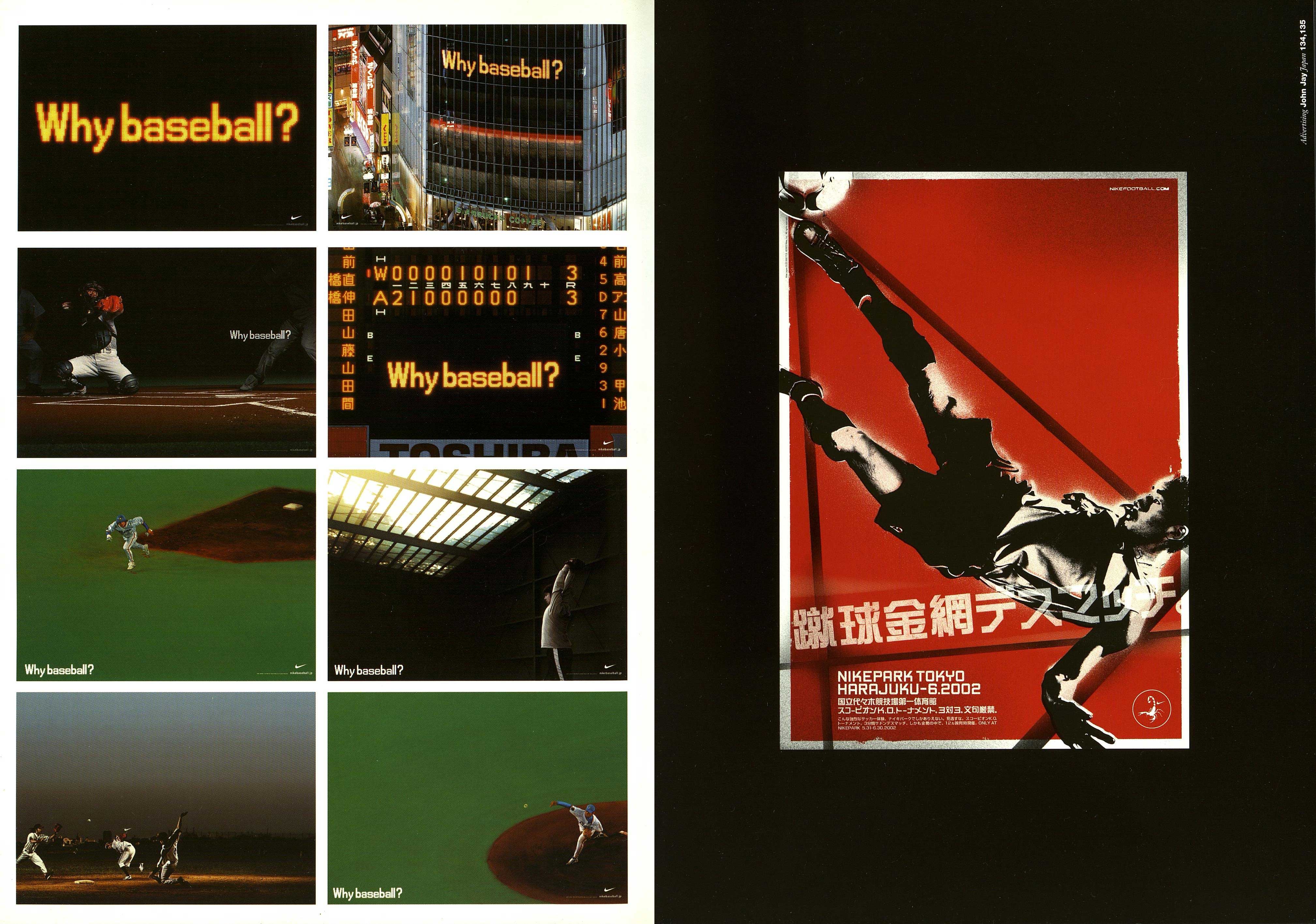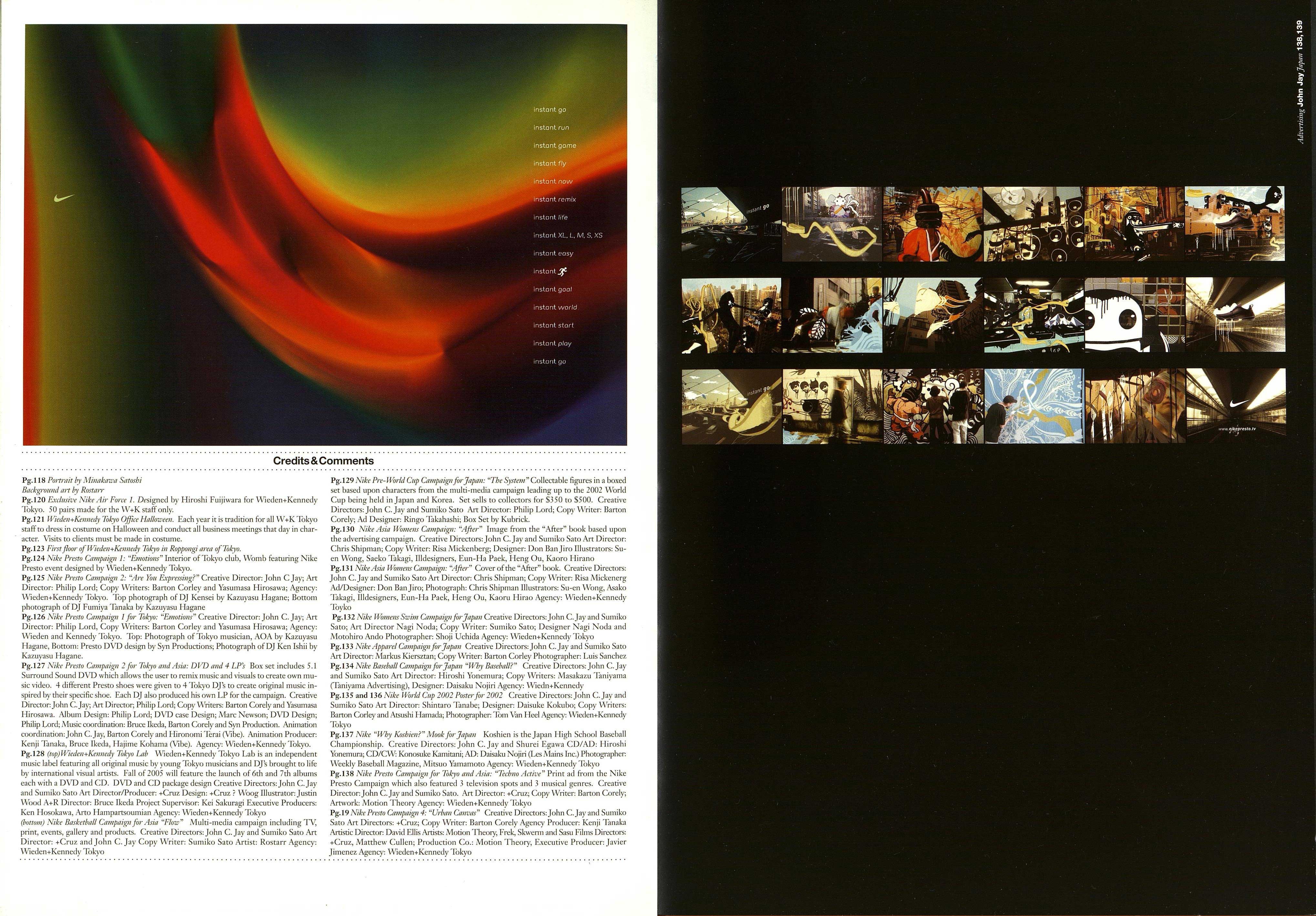'John C. Jay: Weiden+Kennedy's Virtuoso'

Graphis Magazine January 2005
As a partner and Executive Creative Director of Wieden+Kennedy, John C. Jay is breaking new ground in the dynamic Japanese advertising market. But this is nothing new for Jay, an eclectic and innovative figure who made a major impact in the world of design and fashion in the 1980s as creative director at Bloomingdale's department stores before bringing his distinctive flair and style to the ad agency world.
Jay left Bloomingdale's to join W+K in 1993. He spent five years at the agency's Portland headquarters, and then spearheaded the opening of the Tokyo office in 1998. Under Jay and Sumiko Sato, W+K Tokyo has emerged as a kind of experimental lab, where advertising is mixed and blended with equal parts art, music, fashion, and hip street culture. On behalf of its clients (Nike and Japanese brands including Sapporo beer, Sharp Aquos electronics, the educational service Kumon, and others), Jay's team of 60 plus employees often collaborates with local musicians, filmmakers, and visual artists. The result is not merely ads but much more including music videos, art shows, and various live events. The agency has even launched its own independent music label, W+K TokyoLab.







A good example of the agency's multifaceted approach can be seen in its campaign for Nike's Presto line of shoes. From the outset, Jay has enlisted local as well as international hip-hop artists and deejays to create Nike ads in the form of original interpretive art. In effect, Jay handed these artists a Presto shoe and asked them to create original recordings, music videos, DJ mixes, and animated films that were inspired by the actual shoe. The resulting creations (often in the form of CDs or DVDs, with the Nike logo on the label) were then disseminated at local clubs or at live athletic/music events hosted by W+K Tokyo. Some of the recordings created on behalf of this campaign quickly took on a life of their own, becoming collector's items. And all of these efforts have helped to connect Nike Presto with the Japanese youth creative culture in a way that ads could not.
John C Jay recently returned to the headquarter offices of Wieden+Kennedy in Portland Oregon after 6 years in Tokyo. In his new role as Executive Creative Director, he will help to oversee Wieden+Kennedy globally with Dan Wieden. Jay will continue to have a special focus on the Asia offices in Tokyo and Shanghai.
During a recent visit to New York, Jay met with Graphis contributor Warren Berger to discuss what he's up to in Tokyo. As always, Jay arrived stylishly attired: his dramatic black-and-white checked overcoat, designed by Jonio Takahashi, was fashionably frayed at the sleeves. Style is, of course, to be expected from a former Bloomingdale's man, but Jay is just as meticulous in the way he presents his words - taking pains to explain (often following up with long, bulleted emails) the subtleties and intricacies of his agency's current campaigns. If Jay's ideas are not easy to simplify and categorize, the same can be said of the man himself: He blurs the line between designer and ad man, and also between commerce and art. You might say he wears many hats, each one of which is stylish.
Graphis: Ad agencies tend to expand into markets that are booming, but when you opened the Tokyo office of Wieden+Kennedy, Japan was in the midst of a deep recession. Why Tokyo, and why then?
JJ: A recession is a powerful tool in terms of getting new creative work done. That is when new leaders are born, and when people are sick of the status quo and demanding a change. The late 1990s was also a time when Japan was passing from its economic era to an exciting cultural era. In the areas of youth and pop culture and style, Tokyo has since become the place that trend-watchers around the world are focused on. We saw all of this starting to happen six years ago, and we saw it as an opportunity to connect to the power and growing influence of Tokyo's culture. We did not come here to replicate the Portland office of Wieden+Kennedy. From the very beginning we sought to work with the best Japanese talent and Japanese clients - so that we could be true to the culture in which we live.
Graphis: During its brief existence, the Tokyo office has already gained a reputation as an operation on the cutting edge of advertising communication - you've been involved in creating art, musical recordings, live events. Do you see this agency as a laboratory?
JJ: I do - although in one sense that word may make it sound like some kind of small non-profit operation, and that's not the case. The point of everything we are doing is to create relevant and successful work that can help build international brands for our clients. Just because an agency is doing things differently, outside the status quo, should it really be called a lab? Isn't that what ad agencies are supposed to be doing every day?
Graphis: You do use the name "TokyoLab" for the record label you opened last year. Why would an ad agency want to get into the
JJ: We think it can be a profitable business for us, but the main purpose is that it offers an opportunity for us to create something from inside the culture - not from the outside looking in. It made sense for us to start with music, because we had some great success early on producing music for Nike. Since launching the label, we've released three DVD/CD sets in the past year. But this is actually a bigger idea than a music label. This is a separate division of the agency that will concentrate on finding ways of new expression, while allowing us to work with some of the most creative artists out there. The next phase is to move into art exhibitions. We are also in the planning stages of a new book on Tokyo culture. We're looking at creating collectable toy figures. And we are just starting discus-
Graphis: It seems unusual for an ad agency to be involved with something like an art exhibit - usually that kind of sponsorship might come from a consumer brand trying to strengthen its image with the public. Since you don't deal directly with the public, what's the payoff for W+K?
JJ: The creative community is my public. I want the creative community to understand that there's this place called Wieden+Kennedy that is not just an ad agency. I want these independent artists to look at W+K as a place they can trust - an agency they can bring ideas and collaborate with - as opposed to thinking of us as a bunch of commercial whores. We want them to know that we'll treat their work with integrity. Of course, at the end of the day if you ask why are we are doing this it's also because we like it. It's fun, it energizes our own creative people to be around this kind of work.
Graphis: Cultural critics might contend that the deeper W+K penetrates into the realms of art and music, the more you blur the lines between art and commerce. And that may not be a good thing, even if your own intentions are good.
JJ: If people want to give me credit for blurring the lines, I'll take it.
I don't think it's a bad thing. I'll leave it to the artists to decide. I mean you could say some of the same things about gallery owners that you say about advertisers - who's the bigger devil? All I would say is, go to the artists that we've worked with - ask them if they've been pleased with the collaboration. Some of these artists are getting linked up with technology and resources they simply wouldn't have access to otherwise.
Graphis: The agency has also gained a reputation for producing large and unusual live events on behalf of your clients.
JJ: We do a lot of events. We just did a 3-day event for Nike, in which we brought together the best Japanese deejays and turntable artists, and then invited Japanese kids to come and participate in a "freestyle" event where they could show off their skills at soccer footwork, dribbling a basketball, as well as skateboarding. It brought together all kinds of self-expression. We had about 5,000 kids a night come to the event. We also recently curated an exhibit that featured 25 artist who were asked to create sculpture and art based upon a particular Nike shoe. Nike built a structure just for this show and opened it in Paris. To achieve this, you need an awareness of the audience you're trying to reach - in this case, the youth culture. You need to understand the kinds of events that will appeal to that audi-ence, the music they're interested in and the kind of art they will respond to. And we have that level of understanding.
Graphis: Where does that understanding come from - is it a matter of going out to galleries and clubs every night to soak in what's going on?
JJ: No, it's not just about going into nightclubs and taking notes, or sitting at home and studying Details magazine. If you treat this as "cool-hunting," then it becomes pretty shallow. It's about being interested and paying attention to what's going on in the arts, in sociology, and going to seminars, and talking to lots and lots of people. One of the goals I had when we opened our doors was to make our office a conduit of ideas for different kinds of people. We have creative people and business people from all walks of life coming through our doors - I'm talking about DJ's, entrepreneurs, fashion designers, breakdancers, technology people. People like Stash, a graffiti artist from Brooklyn, or Kami, a well-known artist and skater in Tokyo, or Hiroshi Fujiwara, one of the most influential local deejays, or the robot designer Tatsuya Matsui. We mingle with all of those kinds of people.
Graphis: Much of the Nike work you've done in Tokyo has celebrated the notion of individuality in sport - of people doing things their own way, instead of following established rules. Does this reflect a shift in attitudes in Japan - away from the old culture of conformity?
JJ: Well, the old culture is still very powerful. But this event we had recently, with thousands of Japanese kids doing freestyle expression, showing off their moves in public - this would not have been possi-ble five years ago. The kids wouldn't have had that kind of confi-dence. So yes, the culture is changing. And we're trying to get behind that change and reinforce it as much as we can.
Graphis: If W+K Tokyo's work is hard to categorize, the same could be said of you - your career has straddled the worlds of fashion, design, advertising.
JJ: I actually started in editorial, art directing magazines. I always had an interest in fashion - and of course I spent 13 years at Bloomingdale's. And I think of myself as both a graphic designer and an advertising creative director. One thing I hope I can show people is that you can make lateral jumps from discipline to discipline. There's too much of a tendency, I believe, to pigeonhole people. It's like the way people treat photographers - they'll ask, "Are you a still life guy? Okay, but we're doing beer, have you done beer? Okay, was it cans or bottles?" It's ridiculous. People need to understand that talent can cross over into different areas.
Graphis: Do you miss Bloomingdale's?
JJ: I loved that world, I loved being able to touch the product. The first time Rauschenberg, Warhol, and Jasper Johns work showed their work was in department store windows. Department stores understood how to create a complete experience. I laugh at the way ad agencies have in recent years talked about "integrated marketing" as if it's something new - the truth is, department stores created that. But the reason department stores no longer have the cultural power they once had is that they are no longer windows to the world. They're no longer conduits of culture - it's just commerce now. Buyers who used to rely on personal taste and intuition now rely on computers. There are very few great merchants left.
Graphis: You went from a Manhattan department store to a Portland ad agency, and then onto Tokyo. Has it been tough adjusting?
JJ: When Dan Wieden asked me to come out and join the agency, I was afraid to leave New York at first. Going from Manhattan to Portland was a big adjustment. In a way, going to Tokyo was like coming home to a big city. I didn't plan to do it. In fact, I was inter-viewing people in Portland for the job to run the Japanese office. And as I was doing the interviews, I was listening to myself sell these people on how great the Tokyo experience was going to be. Then I called Dan and said "I found the guy - it's going to be me."
Writer: Warren Berger
Photos: Minakawa Satoshi
Credits and comments:
Pg.119 Background art by Rostarr
Pg.120 Exclusive Nike Air Force 1. Designed by Hiroshi Fuijiwara for Wieden+Kennedy Tokyo. 50 pairs made for the W+K staff onlv.
Pg.121 Wieden+Kennedy Tokyo Office Halloween. Each year it is tradition for all W+K Tokyo
start to dress in costume on Halloween and conduct all business meetings that day in character. Visits to clients must be made in costume.
Pg.123 First floor of Wieden+Kennedy Tokyo in Roppongi area of Tokyo.
Pg. 124 Nike Presto Campaign 1: "Emotions" Interior of Tokyo club, Womb featuring Nike Presto event designed by Wieden+Kennedy Tokyo.
Pg. 125 Nike Presto Campaign 2: "Are You Expressing?" Creative Director: John C Jay: Art Director: Philip Lord; Copy Writers: Barton Corley and Yasumasa Hirosawa; Agency:
Wieden+Kennedy Tokyo. Top photograph of DJ Kensei by Kazuyasu Hagane; Bottom photograph of DJ Fumiya Tanaka by Kazuyasu Hagane
Pg.126 Nike Presto Compaign 1 for Tokyo: "Emotions" Creative Director: John C. Jay; Art Director: Philip Lord, Copy Writers: Barton Corley and Yasumasa Hirosawa; Agency:
Wieden and Kennedy Tokyo. Top: Photograph of Tokyo musician. AOA by Kazuvasu Hagane, Bottom: Presto DVD design by Syn Productions; Photograph of DJ Ken Ishii by Kazuyasu Hagane.
Pg.127 Nike Presto Campaign 2 for Tokyo and Asia: DVD and 4 LP's Box set includes 5.1
Surround Sound DVD which allows the user to remix music and visuals to create own mu-sie video. 4 different Presto shoes were given to 4 Tokyo DI's to create original music inspired by their specific shoe. Each DJ also produced his own L.P for the campaign. Creative
Director ohn d lag detOroctor Phian art dant Uritong Karton Caroly and Yacumoce
Hirosawa. Album Design: Philip Lord; DVD case Design; Mare Newson; DVD Design;
Philip Lord; Music coordination: Bruce Ikeda, Barton Corely and Syn Production. Animation coordination: John C. Jay, Barton Corely and Hironomi Terai (Vibe), Animation Producer:
Kenji Tanaka, Bruce Ikeda, Hajime Kohama (Vibe). Agency: Wieden+Kennedy Tokyo.
Pg. 128 (top) Wieden+Kennedy Tokyo Lab Wieden+Kennedy Tokyo Lab is an independent music label featuring all original music by young Tokyo musicians and DJ's brought to life by international visual artists. Fall of 2005 will feature the launch of the and 7th album each with a DVD and CD. DVD and CD package design Creative Directors: John C. Jay and Sumiko Sato Art Director/Producer: +Cruz Design: +Cruz? Woog Illustrator: Justin Wood A+R Director: Bruce Ikeda Project Supervisor: Kei Sakuragi Executive Producers:
Ken Hosokawa, Arto Hampartsoumian Agencv: Wieden+Kennedy Tokvo (bottom) Nike Basketball Campaign for Asia "Flow" Multi-media campaign including TV. print, events, gallery and products. Creative Directors: John C. Jay and Sumiko Sato Art
Director: +Cruz and John C. Jay Copy Writer: Sumiko Sato Artist: Rostarr Agency:
Pg. 129 Nike Pre-World Cup Campaign for Japan: "The System" Collectable figures in a boxed set based upon characters from the multi-media campaign leading up to the 2002 World Cup being held in Japan and Korea. Set sells to collectors for $350 to $500. Creative Directors: John C. Jay and Sumiko Sato Art Director: Philip Lord; Copy Writer: Barton Corely; Ad Designer: Ringo Takahashi; Box Set by Kubrick.
Pg.130 Nike Asia Womens Campaign: "After" Image from the "After" book based upon the advertising campaign. Creative Directors: John C. Jay and Sumiko Sato Art Director:
Chris Shipman; Copy Writer: Risa Mickenberg; Designer: Don Ban Jiro Illustrators: Su-en Wong, Sacko Takagi, Ildesigners, Eun-Ha Pack, Heng Ou, Kaoro Hirano Pg.131 Nike Asia Womens Campaign: "After" Cover of the "After" book. Creative Directors:
John C. Jay and Sumiko Sato Art Director: Chris Shipman; Copy Writer: Risa Mickenerg Ad/Designer: Don Ban Jiro; Photograph: Chris Shipman Illustrators: Su-en Wong, Asako Takagi, Illdesigners, Eun-Ha Pack, Heng Ou, Kaoru Hirao Agency: Wieden+Kennedy Toyko
Pg. 132 Nike Womens Swim Cambaion for Tavan Creative Directors: John C. Javand Sumiko Sato; Art Director Nagi Noda; Copy Writer: Sumiko Sato; Designer Nagi Noda and Motohiro Ando Photographer: Shoji Uchida Agency: Wieden+Kennedy Tokyo
Pg. 133 Nike Apparel Campaign for Japan Creative Directors: John C. Jay and Sumiko Sato
Art Director: Markus Kiersztan; Copy Writer: Barton Corley Photographer: Luis Sanchez Pg.134 Nike Baseball Campaion for Japan "Wby Baschall?" Creative Directors: John C. Jay and Sumiko Sato Art Director: Hiroshi Yonemura; Copy Writers: Masakazu Taniyama (Tanivama Advertising). Designer: Daisaku Nojiri Agencv: Wiedn+Kennedy
Pg.135 and 136 Nike World Cup 2002 Poster for 2002" Creative Directors: John C. Jay and Sumiko Sato Art Director: Shintaro Tanabe: Designer: Daisuke Kokubo: Copy Writers:
Barton Corley and Arsushi Hamada; Photographer: Tòm Van Heel Agency: Wieden+Kennedy Tokyo
Pg.137 Nike "Why Kobien?" Mook for Japan
Koshien is the Japan High School Baseball Championship.
Creative Directors: John C. Jay and Shurei Egawa CD/AD: Hiroshi
Yonemura; CD/CW: Konosuke Kamitani; AD: Daisaku Nojiri (Les Mains Inc.) Photographer:
Weekly Baseball Magazine, Mitsuo Yamamoto Agency: Wieden+Kennedy Tokyo
Pg.138 Nike Presto Campaign for Tokyo and Asia: "Techno Active" Print ad from the Nike Presto Campaign which also featured 3 television spots and 3 musical genres. Creative Director: John C. Jay and Sumiko Sato. Art Director: +Cruz; Copy Writer: Barton Corely;
Artwork: Motion Theory Agency: Wieden+Kennedy Tokyo
Pg.19 Nike Presto Campaign 4: "Urban Canus" Creative Directors: John C. Jay and Sumiko
Sato Art Directors: +Cruz: Copy Writer: Barton Corely Agency Producer: Kenii Tanaka
Artistic Director: David Ellis Artists: Motion Theory, Frek, Skwerm and Sasu Films Directors:
+Cruz, Matthew Cullen; Production Co.: Motion Theory, Executive Producer: Javier Jimenez Agency: Wieden+Kennedy Tokyo
